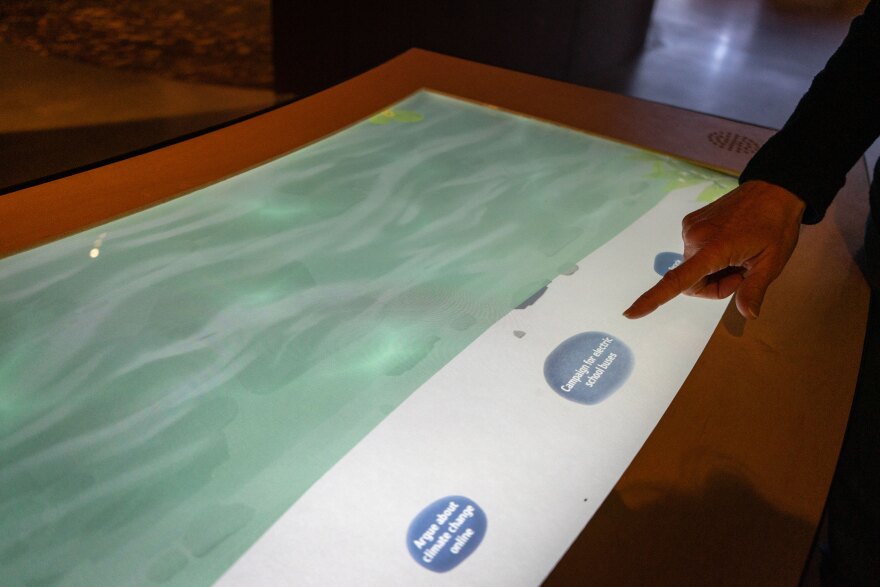A new Utah exhibit wants to address the negative emotions around climate change. It’s called A Climate of Hope.
The Natural History Museum of Utah in Salt Lake City is one of the first in the country to try this approach to the topic. It’s been sharing content and concepts with the Oregon Museum of Science and Industry, and the Smithsonian recently visited in preparation for its new exhibit.
The first step into NHMU’s permanent display leads into a grove of real aspen trees where you’ll be greeted by birds singing and the sound of the wind blowing through the leaves. Visitors are given a row of buttons they can press to give an answer about how they’re feeling about climate change. The forest reflects the button chosen. Press anger or hopelessness and you’ll hear sharp lightning and howling wolves.

Marti Weber, a Salt Lake County patron, felt a little anxiety and fear.
“Not so worried for our own personal selves, but for the generations that are coming right now,” she said. “What’s life going to be like?”
Often, discussions of where we’ll be in the future can be “pretty dystopian” or “apocalyptic,” said exhibit creator Lisa Thompson. And she doesn’t think that’s “a productive point at which we can begin to tackle the challenges we face.” Sometimes it feels like the weight of the planet rests on one person’s shoulders — recycling, shopping with reusable bags, driving less — but Thompson said that’s a narrative put out by the fossil fuel industry.
“Because it throws the responsibility back on you. You have to reduce your carbon footprint. You are the problem.”
In the exhibit, a virtual pond with lots of croaking frogs addresses that.

It’s a game. Each virtual rock is labeled with an action people can take. You can toss one in the water to see what kind of a splash it makes. Choose “recycle,” and it makes a small plop.
“Individual actions are good,” the display reads, “but don't make big waves enough to change the system.”
As Thompson explained, “those individual-level actions aren't going to be enough to shift the energy system, and it also makes people feel guilty. And sometimes those solutions are simply beyond people's reach.”
A bigger rock, labeled “Volunteer at a Clean Energy nonprofit,” makes a deeper splashing sound.
“There's something really hopeful about being in community and taking action with other people,” Thompson said. “And it's those connections that are really important that will lead to further solutions.”
In the next part of the exhibit, wooden triangles spin on a free-standing wall. The green and blue blocks highlight different projects around the state with pictures and descriptions. The museum intends to update the blocks every year to show new projects.

“You can see for yourself all the amazing different kinds of solutions that are being implemented,” Thompson said. “Whether it's figuring out how to reduce food waste or the Soil Health Partnership. Healthy soil can sequester more carbon dioxide, which helps mitigate climate change.”
Sometimes, thinking about all of the things that could change as society responds to the climate can be scary. The exhibit tackles that with little wooden homes; flip a switch, and they light up to show a future that might look familiar.
“There's often been a frame of sacrifice in the past that in order to make this transition, that you're going to have to give up a lot, and you're not going to be able to do the things that you like to do,” Thompson said. “But that's just simply not the case.”
Take renewable energy for example — people worry it will be expensive and raise their utility bills. She said that if we transition, energy becomes “much cheaper and much more abundant.”
“It's just a matter of running things with electricity generated with renewable energy instead of by fossil fuels.”

The last part of the exhibit is a display with guidance on how to have conversations about climate change, complete with funny gifs for each answer.
People disagree on what a better future should look like, but through conversation “we can come together around our differences and find out what are the shared values that we do have,” she said.
Once Marti Weber had been through the whole exhibit, she said she felt more empowered and was thinking about talking to people at her community center.
“Sitting around the table and maybe steering the conversation toward climate change and not just talking about the neighbors' pets or whatever.”
Weber also felt a little more hopeful.
“Possibly it could make a difference, that maybe, maybe more people thinking about this will finally get the action that we need.”
Disclosure: The Natural History Museum of Utah is a sponsor of KUER.






